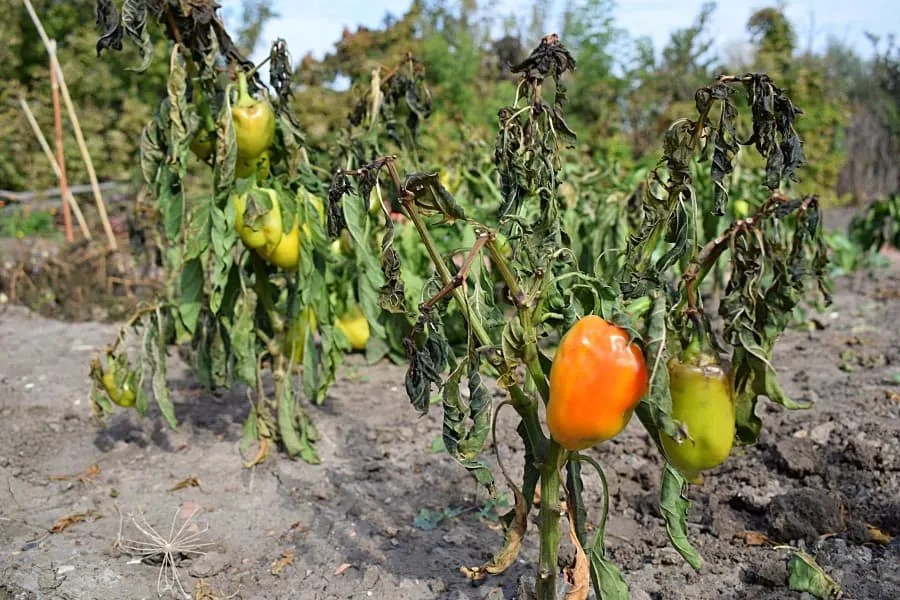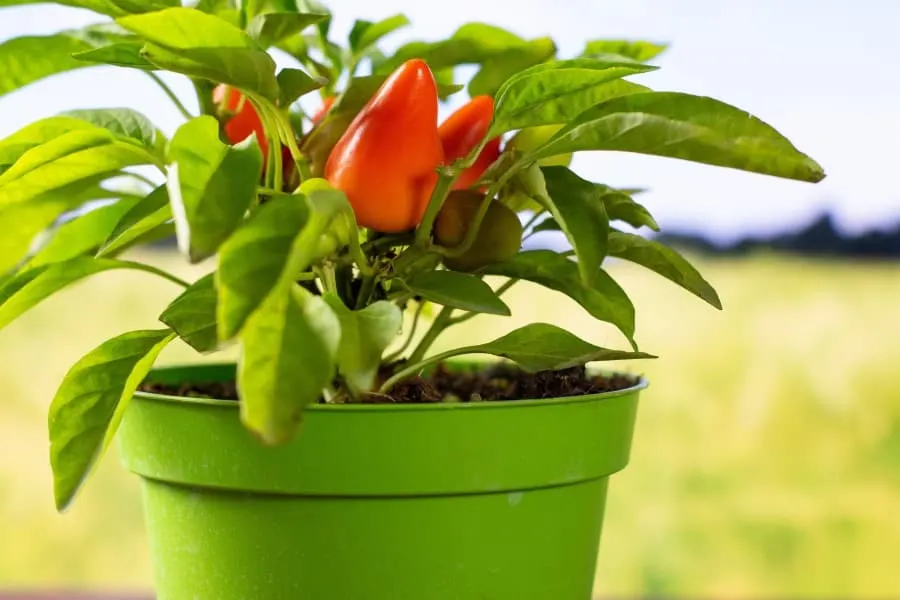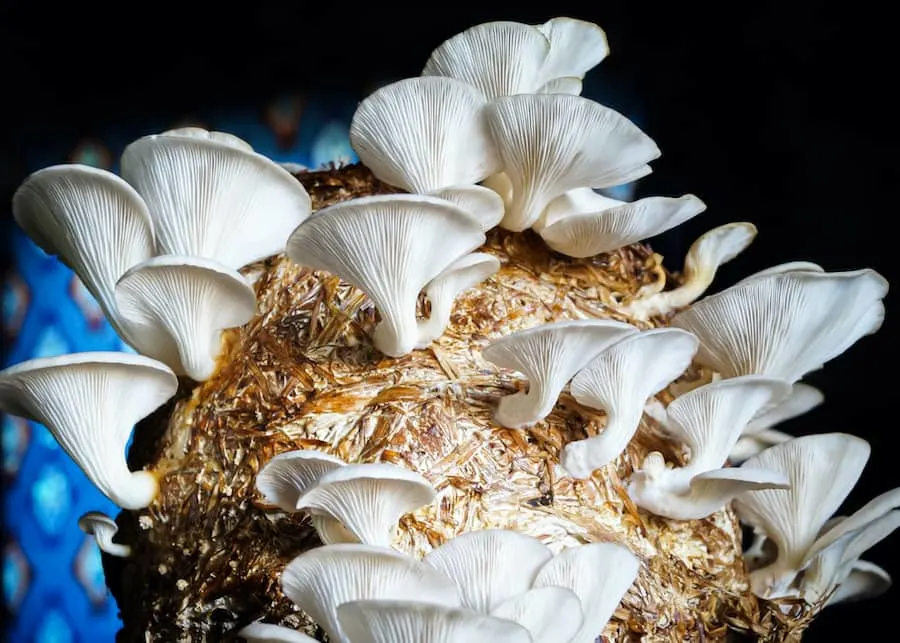Pepper plants are loved worldwide for their endless variety, low-level maintenance, and the hot, spicy rewards they bring to the kitchen table. Pepper plants can be cared for by expert gardeners and first-time cultivators alike. However, growth issues are common and can affect your plant’s health in the long term.
Stunted pepper plants are usually a result of stress from improper watering, poor weather conditions, low levels of nutrition, or insufficient light. Pests, viruses, and fungi can also affect pepper plant growth.

Here is a quick overview of the necessary conditions for good pepper growth, as well as common pests, bacteria, and viruses to keep an eye out for. These might vary, depending on the pepper you are growing, but are generally common among most peppers.
| Water requirements | Every day during summer. Every 2 to 3 days in the cooler months. It’s best to check how damp the soil is before giving your plant more water. |
| Temperature | Between 70 and 80 degrees Fahrenheit (21 -26 degrees Celsius) |
| Fertilizer | Manure, compost, or 5-10-10 fertilizer. Add 1 to 2 inches (2.5 – 5 cms) per week. |
| Light | 6 to 8 hours of sunlight per day |
| Common pests | Spider mites, mites, whiteflies, aphids |
| Common Fungi and Bacteria | Southern blight, bacterial leaf spot |
| Common Virus | Mosaic virus |
If you have noticed that your pepper plant’s growth has been stunted, it is crucial to act fast to prevent long-term problems. Luckily, resolving most issues is not challenging – all you have to do is identify the cause behind stunted growth and apply the correct solution!
How Can you Tell if Your Pepper Plant Is Stunted?
In botany, a “stunt” is a health condition that can affect indoor and outdoor plants. It causes plants to suffer from a loss of vigor, reduced growth rate, and dwarfism. The most common cause behind stunt in plants is stress, often caused by environmental factorsor because of a recent move.
If you have recently moved your plant from an area of the house to another, or a new place altogether, for example, you might notice the plant wilting, yellowing, or in poor health. These issues can also appear between seasons.
You can learn more about plant stress in the video below, created by the Smithsonian Gardens:
If the weather is rapidly becoming colder, but you have not adjusted your plant’s watering schedule, they can suffer the effects and consequences of overwatering. Similar issues can appear if you have moved your pepper plant to a location that is too dark or too cold.
If you have noticed that your pepper plants are stunted, it is crucial to act fast. If your plant is still young, the effects of a stunt can carry on throughout its life span, even shortening it and reducing its vigor. In the end, if you don’t address the problem as soon as you notice it, your plant might not develop flowers or fruits.
When trying to resolve a stunt quickly and efficiently, it is crucial to understand its cause. Once you have identified the cause, you should be able to safely troubleshoot the issue.
Common Reasons for Pepper Plant Stunting and Remedies

Listed below are some of the common reasons pepper plants get stressed that might result in stunted growth. This will help you identify the problem in your pepper plant and take the right steps to address the problem.
Be Mindful of Watering Levels
Pepper plants thrive in soil that is moist and nutritious, but they also require proper drainage. Too much water or not enough time between waterings can cause the moisture to accumulate in the potting mix. This can encourage the growth and proliferation of bacteria, cutting the plant’s supply of nutrients and oxygen.
If you are looking for general watering guidelines, you should allow the soil to dry between watering the plant again. The best test is to check the dampness of the soil using your fingers to determine whether or not you need to water your pepper plant. Water your plants every day during the hot season and reduce the watering to once every two or three days during spring and winter.
Insufficient Light
Light is a crucial source of energy and nutrients for your plant and, without the correct exposure to sunlight, your plant can stop growing. Limited access to light will prevent the plant’s photosynthesis process, through which it creates essential nutrients.
In general, most pepper plants need an average of six to eight hours of sunlight per day. Depending on the variety, your plant might require up to nine hours of daylight, so it’s important to know what amount of light is best for the kind of pepper you are growing.
If your pepper plant’s leaves become wilted and start to yellow, and its growth has been stunted, the culprit might be the level of sunlight exposure. Move your plant near a south-facing window to ensure it benefits from as much light as possible. You can also consider adding grow lights to your set up, to provide your plant with the necessary amount of light it needs to thrive.
The Soil Might be Low in Nutrients
When looking for the perfect potting mix for your pepper plants, make sure you start with well-drained soil. If you notice your plant begin to wilt and yellow, the ground might be low in nutrients.
It is important to add organic matter such as compost or manure to increase the nutrient level of your soil. If you don’t have these materials at your disposal, you might opt for a fertilizer.
The best type of fertilizer for pepper plants is a 15-15-15 or a 5-10-10, depending on the type of pepper plant, the growing condition, and its life stage. The three figures refer to the three essential compounds for plant growth: nitrogen, phosphorus, and potassium. When combined, the three nutrients assist the plant in its foliage, flower, and fruit production. To learn more about the best fertilizers for pepper plants we have an entire post on the subject.
A fertilizer that is well-balanced and mild can help your plants flourish, especially if you have not changed the soil in a while or they are planted in a pot. Fertilizer is not a solution to all problems, however, so you should consider moving the plant into a more suitable environment, if it does not address the problem of stunted growth. Be sure to check out this post on the right soil to use for pepper plants.
Your Pepper Plant Might Be Affected by a Virus
Viruses are not one of the most common causes of stunted pepper plants, but they can be the reason behind the plant’s premature death. One of the most common viruses that affect pepper plants is the tobacco mosaic virus. This virus is spread by insects such as aphids and can infect most of your house plants if not properly treated.
Some of the tobacco mosaic virus symptoms are the plant’s leaves turning light green and becoming malformed. The leaves can also look curved and dwarfed, while fruits are prevented from developing.
If you identify the tobacco mosaic virus in your pepper plant, you should make sure to do the following three steps:
- Get rid of all infected plants. This virus spreads quickly across all plants, so be sure to remove and discard any plants that are infected by it
- Remove weeds. Some weeds might allow the virus to spread, so make sure your garden is free of weeds.
- Disinfect garden tools and wash your hands. The biggest culprit in the spread of the virus is the gardener, so make sure you wash your tools and your hands regularly, especially before you handle your plants.
Pests Might Be Attacking Your Plant
If your plant comes under attack by pests and diseases, it is likely to suffer from stunted growth. Pests, especially as the colonies start to develop and grow, will suck nutrients, moisture, and oxygen out of the plant. When your pepper plant can’t replace such nutrients quickly enough, its growth rate can slow down.
Some of pepper plants’ most common pests include:
- Spider mites
- Mites
- Whiteflies
- Aphids
There are several steps you can take to fight off pests and infestations. One solution is to use organic insecticides, which you can either buy or make at home. Most of these sprays include natural elements such as salt, pepper, garlic, or mineral oils.
A Fungus Might Have Compromised Your Pepper Plant

The two most common fungi and bacteria affecting pepper plants are Southern blight and bacterial leaf spot. When one of your plants is contaminated by these fungi and bacteria, it will start to develop spots on the leaves, which will look darkened and blackened.
When affected, the plant will focus its energy and strength on fighting the diseases rather than on their growth and vigor, resulting in stunted growth.
Blight is found commonly in gardens and fields because the rain will splash soil all about and leave plants soaking in standing water at times, which is how blight mold spores multiply. This is why it’s important to make sure you don’t over-water your plants. If your pepper plants get dry, provide multiple smaller watering sessions throughout the day to avoid drowning them in too much water.
The Temperature is Too Low
The ideal temperature range for your pepper plant is between 70 and 80 degrees Fahrenheit (21 and 27 degrees Celsius), but it can be as high as 85 degrees Fahrenheit for some spicy varieties. Pepper plants are native to warm, tropical climates, so it is recommendable to create moist, hot environments to allow them to thrive.
Their growth can be stunted if kept in cold climates. If you know that a frost is on the way, make sure to move the plants indoors when possible or wrap them in plastic to keep them warm and safe.
Closing Thoughts
Pepper plants are low-maintenance plants that can thrive both indoors and outdoors. While they are not often affected by severe problems, their growth can be stunted if they are not cultivated in the right conditions.
Make sure your plants are thriving by keeping them in a warm and humid area. The soil should be moist, drained, and regularly fertilized. Keep an eye out to make sure your pepper plants don’t succumb to any diseases or pests. If you keep these in check, your pepper plants should be healthy!
Here are Some of my Favorite Gardening Products and Tools
Thank you for reading this article. I hope you found it helpful for growing some new plants in your home or garden. Here are some products I like that I hope you’ll also find helpful. These are affiliate links, and I am compensated for referring traffic. But in all honesty, these are the exact product that I use or recommend to everyone.
Soil: For high-quality soil, I really like Fox Farm Ocean Forest. I do all my growing in containers and this soil has worked great for me. I like how they use nutrient-rich contents like earthworm castings, bat guano, and composted crab and fish.
Fertilizer: Currently I am using a seaweed-based organic fertilizer call Neptunes Harvest. This is a great milder fertilizer option if you want to use something organic. If you want a more powerful fertilizer, I recommend Fox Farm Liquid Nutrient Trio, lots of people have had great growing success with this product.
Pruning Shears: Pruning shears are one of the most useful gardening tools to have because it’s important to prune your plants to keep them healthy. The pruning shears I recommend are the Gonicc 8’’ pruning shears. I like them because they are built sturdy and work both on bigger and smaller plants, so you don’t need to have multiple pruning shears.
spicytrio.com is a participant in the Amazon Services LLC Associates Program, an affiliate advertising program designed to provide a means for sites to earn advertising fees by advertising and linking to Amazon.com. spicytrio.com also participates in affiliate programs with other sites. spicytrio.com is compensated for referring traffic and business to these companies.
